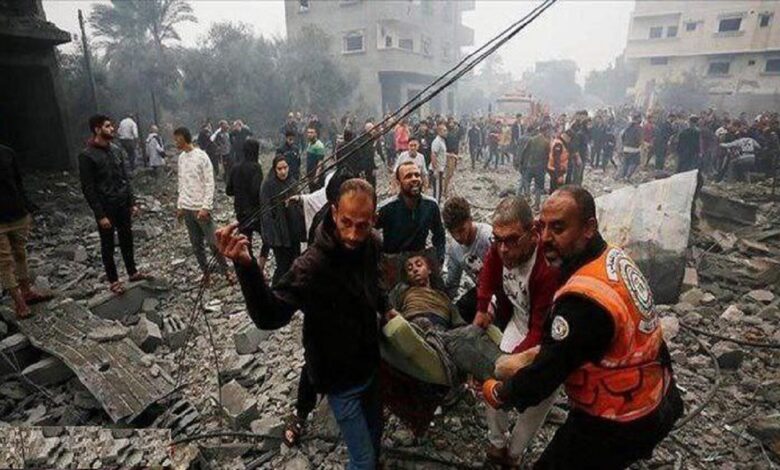Possible scenarios in Gaza after the failure of the Cairo negotiations

| It seems that Netanyahu will continue to insist on the continuation of the war and oppose its cessation due to his personal and party interests and his inability to achieve his declared goals. |
It seems that Netanyahu will continue to insist on the continuation of the war and oppose its cessation due to personal and party interests and the inability to realize his declared goals, and this raises questions about possible scenarios. It has established a ceasefire after failing to reach an agreement. Cairo negotiations, which continued for several days with the aim of reaching a ceasefire agreement in the Gaza Strip, ended on Thursday without achieving any results in the framework of efforts to establish a ceasefire in the holy month of Ramadan; This is despite the fact that the stubbornness and single-mindedness of the Zionist regime has caused its failure.
According to “Al-Khalij Online” report, the purpose of these negotiations was to achieve a 40-day ceasefire starting from the month of Ramadan, as well as the release of dozens of Israeli and Palestinian prisoners and increasing aid to the Gaza Strip. A region that has faced extreme hunger.
As it seems, the cabinet of Benjamin Netanyahu, the prime minister of the Zionist regime, continues to fight and with any solutions to stop the war, because of his personal and party considerations and interests, and also because he could not announce the goals. has been realized until today, he opposes. This has raised questions about possible scenarios after the failure to reach a ceasefire agreement.
According to what the Reuters news agency published citing a senior Hamas official, the Zionist regime has failed all the efforts of the mediators to reach an agreement due to its insistence on opposing the cessation of aggression and the withdrawal and return of the refugees.
Al Jazeera network also reported, quoting unnamed sources, that “the Zionist regime has opposed Hamas’ request for a permanent ceasefire and the withdrawal of its army from the Gaza Strip and the return of refugees without any conditions.” These sources also added that “the mediators tried to bring closer the views between the 2 delegations of Hamas and the occupying regime, but their efforts did not come to fruition”.
In its first reaction after the end of the meetings, Hamas announced that its delegation left Cairo for “consultations with the leaders, and negotiations and efforts to stop the aggression and the return of the refugees continue.”
On the other hand, Egypt’s “Al-Qaira Al-Akhbariya” channel, citing a responsible source, reported that “negotiations between all parties to reach a ceasefire continue before Ramadan, and these negotiations will resume next week.”
>
What demands do Hamas and the Zionist regime have?
The talks in Cairo started last week with the aim of establishing a ceasefire before the holy month of Ramadan with the participation of Egypt, America, Qatar and Hamas in the absence of the Zionist regime. In the past few days, the three countries tried to reach a truce for 6 weeks in the first stage, to exchange prisoners between Hamas and the Zionist regime, and to receive humanitarian aid, but they failed in this regard.
The proposal presented by the mediating countries stipulates the cessation of hostilities for 6 weeks and the release of 42 detainees in Gaza in exchange for the release of Palestinian prisoners from the prisons of the Zionist regime, but Hamas based on the document presented by “Khalil al-Hiya” one of the leaders of this movement. has stipulated the cessation of war a week before the start of the implementation of the agreement and the withdrawal of the occupiers from the Gaza Strip along with international guarantees. Al-Hiya has stated that this movement will never accept the title of “humanitarian ceasefires”, but emphasizes the necessity of a complete cessation of aggression.
Also, based on the leaked document, Hamas has presented the list of the names of the first group of prisoners for the exchange operation, demanding the release of 160 prisoners with heavy and old sentences, which include the names of “Marwan Al-Barghouthi”, “Ahmad Saadat”. “, “Abdullah Al-Barghouthi”, “Ibrahim Hamed” and “Abbas Al-Sayed” and the rest of the names in this list are based on the type of sentence and its duration without considering the group or geography (place of residence).
However, according to Western media reports, Hamas has demanded that the Zionist regime adhere to a permanent ceasefire during or after the three stages of the release of the hostages. The agreement on the terms is the first step, a position that has been supported by Washington and opposed by Hamas.
intensification of aggression
After five months of America’s unlimited support of the Zionist regime in this regime’s war against the Gaza Strip, this country has faced difficulties by limiting Netanyahu’s direction and changing his approach regarding the war. America aims to reach an agreement within days. The future was putting pressure due to the fear of expanding the scope of conflict and confrontation during the month of Ramadan. Meanwhile, US President Joe Biden asked the Egyptian and Qatari partners to put pressure on Hamas to accept the proposal to stop the war despite the movement’s reservations regarding many of its provisions.
Mohammed Marouf, a Palestinian writer and analyst, says that the possible scenario after the failure of the negotiations with the occupiers is that the Rafah operation will begin and the Zionist regime will advance its plan in this region as a lifeline, in Netanyahu’s words. He believes that in such a case, unpredictable dramatic paths may begin in the entire region, because the victory of the resistance will mean consequences that will not be limited to the occupying regime and its army and power.
Maarouf added that on the other hand, the risk of failure of the resistance, if it is serious, will make the cost of starting a big war in the region on all fronts a real option. The defeat of the resistance does not mean the geographical advance of the army of the occupying regime, but it means the reduction of its power to confront and the success of the occupying army in imposing the rules of conflict in such a way that the resistance and its units cannot break these new rules.
The attacks of the Zionist regime on Gaza
Among the scenarios, the second hypothesis is the beginning of the military operation of the Zionist regime in Rafah, but in such a way that the intensity of its attacks is calm and does not lead to large reactions and is far from the centers of large gatherings of civilians, and casualties in the ranks of civilians in the same The ceiling of normal daily statistics is far from the Philadelphia axis, which arouses Egypt’s anger and dissatisfaction.
This analyst added that “the second hypothesis achieves 2 goals; First, pointing out the seriousness of the operation and preparation for its implementation, whether through a military campaign or heavy fire and its organization, secondly, testing the combat capabilities of the resistance in certain places that the army of the occupying regime has included in its calculations and predictions.
Maarouf Khater points out that “Netanyahu wanted the failure of all negotiations, the most prominent of which is the so-called “Next Day” plan, which includes the complete disarmament of the Gaza Strip and control over the borders with Egypt and handing over the management of the Gaza Strip to elements of the nomads and Eradication of extremism in all institutions and closure of UNRWA (Work and Relief Agency for Palestinian Refugees) and opposition to the Palestinian state.
This analyst added that, but other steps are the arrest of 13 prisoners that the Zionist regime had released in the previous ceasefire agreement and also the announcement of the approval of the construction of 3,500 units in West Bank settlements.
Source: ISNA
| © | Webangah News Hub has translated this news from the source of Young Journalists Club |


